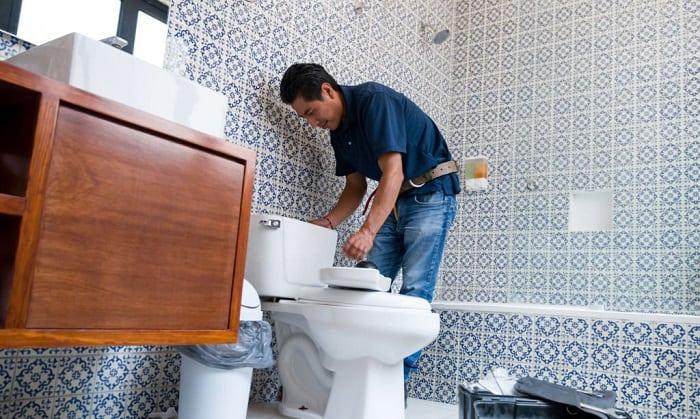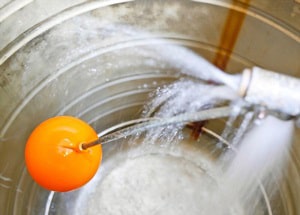A running toilet is a hassle and a loud annoyance. You may be wasting water and increasing your water bill if you leave the toilet running continuously. Typically, a running toilet can be fixed easily.
“Why won’t my toilet stop running?” To answer your question, the underlying cause could be a faulty flapper, inappropriate flapper chain length, unplugged fill tube, or a misplaced float.
Table of Contents
Reasons Why My Won’t Toilet Stop Running
If your toilet runs all the time after flushing, this could cause a lot of problems. Fret no more, because the listed below are the most likely culprits, along with the method to rectify the issue.
1. Faulty or unclean flapper
The most frequent cause of why your toilet won’t stop running is a frayed flapper. As time passes, your flapper will get worn out as they’re constantly used, resulting in water continuously running from the tank to the bowl.
To fix this problem, do the following:
- Turn off the water supply. Then, flush the toilet until the tank is empty. Use a towel to soak all the remaining moisture if the water can’t drain all off.
- Remove the chain attached to the flapper from the toilet.
- Replace the defective flapper with a new one.
- Attach the chain with the new flapper back in its initial position.
- Open the water supply and check if the leak still persists.
2. Chain height between the flush lever and flapper
If the water won’t stop running in the toilet even after checking the flapper, the problem might be on the flapper chain.
The flapper chain controls the flush valve, allowing clean water to flow into the toilet. When the length of the chain is not right, it could prevent the flush valve from fully shutting after flushing, causing the toilet not stop running.
- To get the ideal length for the flapper to settle, relocate the clip to a different chain link.
- To test if the flush valve can simply close, consider flushing the toilet. Continue modifying the chain if this doesn’t work. A decent criterion to follow is to leave a half-inch of extra space.
- Consider using pliers to cut the chain to keep it out of the way once the valve can seal without a problem.
- Ensure the chain is straight and the clip is firmly sealed.
Sometimes it takes numerous tries to resolve this kind of issue. Have the patience to make more adjustments until the desired height of the chain is reached if your toilet keeps running even after the first repair effort.
3. The refill tube has been unplugged
You might need to reattach the refill tube if your toilet won’t stop flushing. A strong indication that the fill tube is the culprit is that the toilet can’t flush fully. An abnormally low level of water in the toilet tank is another telltale sign.
If the fill tube is still in good working condition but the toilet can’t perform a full flush, consider the following steps:
- Step 1: Bring the fill tube and fill valve together tightly to reattach them.
- Step 2: The refill tube should be 1 inch above the overflow tube.
- Step 3: Leave a mark with a pen directly above the water line to gauge the amount of water in the bowl. After that, flush the toilet by carefully adding 1 gallon of water to the bowl. The water needs to be directly beneath the mark.
- Step 4: If there’s too little or too much water going into the bowl, adjust the water level via the float ball.
4. Misplaced float
Without a ball float, the water level will become unstable. So, if your toilet won’t stop on running, also consider checking this aspect.
A float has an influence on the flushing power of your toilet. If the float is positioned too high, water will pour into the overflow tube, forcing the toilet to keep running.
- If the old ball can no longer float, replace it with a new one
- Determine the overflow’s location. The float should be placed ideally 1-2 inches away from that point. Going lower than the point probably wouldn’t produce enough flushing force.
- If there isn’t a floating ball in the tank, yours is probably a fill valve, which is something that usually happens in new style To put the float cup where you want it, merely tighten the adjustment stems.
- An arm float, which is connected to the valve by an adjustment screw on older toilets, has a float ball affixed to it. Twist this adjustment screw to alter the position of the float ball.
- It should be noted that you must flush your toilet after every adjustment to see results.
- Continuously adjusting the float until the water shuts off at the correct level.
5. Broken fill valve
Another indication to explain why your toilet won’t stop running is that the toilet fill valve won’t shut off. When this occurs, leaking is quite likely to happen, necessitating replacement.
The fill valve for your toilet tank, also known as a ballcock, is a crucial part of your toilet and is very important for controlling the water flow.
- Check your fill valve’s functionality by flushing the toilet.
- Try to find leaks coming from the valve’s different components.
- Another method to check if the valve is damaged is to raise the arms float as the water fills. You will have a running toilet if it is.
- Additionally, you can add food coloring to the water tank and wait ten to twenty minutes. During this period, avoid flushing the toilet. The valve is to fault if the color of the water in the bowl changes.
- If all else fails and your toilet tank won’t stop filling persistently, then consider getting a fill valve replacement.
Frequently Asked Questions
What is the most common reason a toilet won’t stop running?
If your toilet won’t shut off following the regular flush cycle, the most common reason for it is a broken toilet flapper.
Although other causes, including an unplugged fill tube, a broken float ball, an incorrect fill valve, or an incorrect flapper chain length, could also be taken into account due to their prevalence.
What to do if your toilet won’t stop running?
If your toilet doesn’t stop running despite all your efforts in fixing it, it’s time to call the professionals. Your toilet might have a deeper problem that can only be properly addressed by those with the expertise.
Is it bad if the ball has sunk while the tank is brimming with water?
No float ball should sink to the bottom unless it’s filled with water. This compromised position prompts water to flow into the tank constantly.
As I’ve already pointed out, no tank should have water level passing the overflow tube. You’ll need to replace the defective float ball to resolve this issue.
Conclusion
Fixing running toilets is an arduous but fulfilling task. If you employ these instructions, you should have the ability to fix your toilet and answer your inquiry, “Why won’t my toilet stop running?”
However, if your toilet won’t stop filling after doing all these methods, then it’s time to call a plumber for help. You might have a bigger problem that could only be assessed and solved by a professional.

I’m Paulk Webb, and I work as a writer for Saveourwaterrebates. I’m happy to put in the time and effort to conduct market research to identify the most pressing issues faced by households concerning their plumbing. Feel free to check out our guides to get the most informed recommendations for how to solve your problems.






